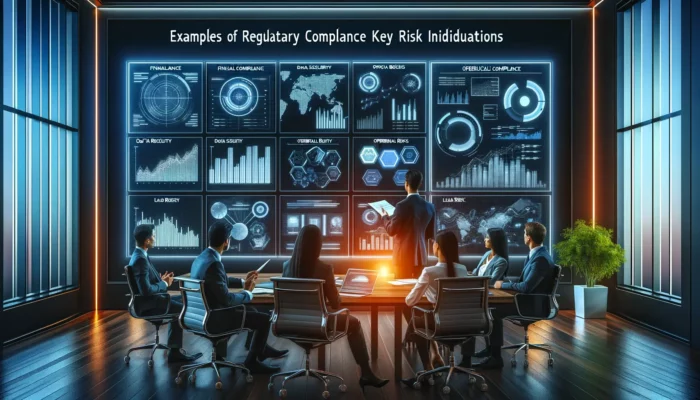The role of technology in the context of Key Risk Indicators (KRIs) is significant for modern risk management. Technology enhances the utility of KRIs by enabling predictive analytics, real-time monitoring, and data visualization.
This allows organizations to proactively identify and manage potential risks before they materialize into significant issues. For instance, risk management software can leverage data to minimize business risk by implementing KRIs effectively (SolveXia).
Furthermore, the integration of KRIs with technology aids in strengthening the risk culture within organizations. Technology facilitates a more informed decision-making process by enabling business managers to recognize the benefits of effective risk management.
This integration can lead to better alignment of risk management with business objectives, ensuring potential risks are identified and addressed promptly (ISACA).
In essence, technology plays a crucial role in enhancing the effectiveness of KRIs as part of comprehensive risk management strategies. It provides tools that improve the ability to monitor, analyze, and mitigate key risks.
Technology has become an integral part of modern business operations, making it essential for companies to have a robust risk management framework.
One of the critical components of such a framework is the use of Key Risk Indicators (KRIs). KRIs are metrics that help organizations identify potential risks and take proactive measures to mitigate them.
In today’s fast-paced business environment, companies must be able to anticipate and manage risks that could impact their operations.
KRIs are an effective tool that can help organizations avoid potential risks by providing real-time insights into key areas of their operations.
Companies can quickly identify potential risks by automating the collection and analysis of KRI data and taking corrective action before they escalate.

Technology has also enabled companies to monitor KRIs in real-time, allowing them to respond quickly to risk-level changes. With the right technology, companies can track KRIs across multiple business units, allowing them to identify trends and patterns that could indicate potential risks.
This level of visibility can help organizations make more informed decisions and take proactive measures to mitigate risks, ultimately leading to better outcomes for the business.
Understanding Key Risk Indicators (KRIs)
Defining KRIs
Key Risk Indicators (KRIs) are critical metrics that help organizations identify and measure potential risks that may impact their operations, financial health, or overall performance.
As defined by COBIT 5 for Risk, KRIs are metrics demonstrating that the enterprise is or has a high probability of being, subject to a risk exceeding the defined risk appetite.
KRIs provide early warning signals that help organizations identify, analyze, and address risks before they escalate into significant issues.
The Role of KRIs in ERM
KRIs play a crucial role in Enterprise Risk Management (ERM) by enabling organizations to monitor and assess risk exposure.
Organizations can use Key Risk Indicators (KRIs) to identify patterns and trends in their risk profile, enabling informed risk mitigation and management decisions.
KRIs help organizations align their risk management strategies with their overall business objectives and risk appetite, ensuring they are prepared to handle potential risks that could impact their operations.
KRI Identification and Tracking
The process of identifying and tracking KRIs involves several steps. First, organizations must define their risk appetite and identify the potential risks that could impact their business operations.
Once risks have been identified, organizations must determine the most critical KRIs to help them monitor and assess them. KRIs should be specific, measurable, and relevant to the organization’s risk profile.
Once KRIs have been identified, organizations must track them regularly to ensure they provide accurate and timely information about potential risks.
KRIs should be tracked using a consistent and standardized process to ensure they are reliable and comparable over time.
Organizations should also establish thresholds for their KRIs, which will help them determine when a risk has exceeded their risk appetite and requires action.
Overall, KRIs are essential metrics that help organizations identify and manage potential risks that could impact their business operations.
Organizations can align their risk management strategies with business objectives and risk appetite by understanding the role of KRIs in ERM.
Technology’s Impact on Risk Management
With the increasing complexity of business operations, it is essential to have a robust risk management system in place.
Technology has significantly enhanced risk management by providing tools to automate risk assessments and measure risk exposure.
Automating KRIs
Technology has enabled organizations to automate the collection and analysis of Key Risk Indicators (KRIs). KRIs are metrics that indicate an organization’s level of risk exposure.
KRIs’ automation can help organizations monitor risks in real-time and take corrective action promptly. Technology can also help organizations identify and prioritize risks based on their impact and likelihood of occurrence.
Advanced Measurement Approach
Technology has enabled organizations to adopt an advanced measurement approach to risk management. Advanced measurement approaches involve using statistical models to quantify risks and calculate capital requirements.
These models can analyze large amounts of data to identify patterns and correlations that may not be visible to the human eye.
Advanced measurement approaches can help organizations improve risk management by providing a more accurate assessment of risk exposure.
Data Analytics in Risk Assessment
Technology has enabled organizations to use data analytics in risk assessment. Data analytics can help organizations identify risks and opportunities by analyzing large amounts of data.
This can include data from internal sources such as financial statements and customer data and external sources such as market data and social media.
Data analytics can also help organizations identify trends and patterns that may not be visible through traditional risk assessment methods.
In addition to the above, technology has enabled organizations to create dashboards that provide real-time information on key risk indicators. Dashboards can help organizations to monitor risks and take corrective action promptly.
Technology has significantly impacted risk management by providing tools to automate KRIs, adopt advanced measurement approaches, and use data analytics in risk assessment.
Organizations that leverage technology in their risk management processes can improve their capabilities and make more informed decisions.
Key Performance Indicators (KPIs) vs. KRIs
Key Performance Indicators (KPIs) and Key Risk Indicators (KRIs) are two important metrics organizations use to measure their performance and risk exposure.
While KPIs focus on measuring the success of an organization’s key objectives and goals, KRIs are designed to signal potential operational and strategic risks affecting businesses.
This section will define KPIs and KRIs, discuss their interrelation, and how to balance metrics.
Defining KPIs
KPIs are quantifiable measures used to evaluate the success of an organization in achieving its key objectives and goals.
They are used to track progress over time and to provide a basis for comparison with other organizations in the same industry. KPIs are typically developed based on the organization’s strategic objectives and are consistent across different departments.
Interrelation with KRIs
While KPIs focus on measuring the success of an organization’s key objectives and goals, KRIs are designed to signal potential operational and strategic risks affecting businesses.
KRIs are measurable metrics that offer early warnings to prevent deviations from KPIs. By tracking changes in risk exposure, KRIs help organizations anticipate potential problems and take corrective action before they occur.
Balancing Metrics
Organizations need to balance their use of KPIs and KRIs. While KPIs are important for measuring the success of an organization’s key objectives and goals, they do not provide a complete picture of an organization’s risk exposure.
KRIs, on the other hand, provide a more comprehensive view of an organization’s risk exposure but do not measure the success of an organization’s key objectives and goals.
Therefore, organizations must use KPIs and KRIs to understand their performance and risk exposure.
KPIs and KRIs are important metrics organizations use to measure their performance and risk exposure. While KPIs focus on measuring the success of an organization’s key objectives and goals, KRIs are designed to signal potential operational and strategic risks affecting businesses.
Organizations need to balance their use of KPIs and KRIs to get a complete picture of their performance and risk exposure.
Establishing Effective KRI Monitoring
Key risk indicators (KRIs) are critical to technology risk management. Organizations must set thresholds and trigger levels to establish effective KRI monitoring, conduct ongoing risk monitoring, and implement escalation procedures.

Setting Thresholds and Trigger Levels
Thresholds and trigger levels are key components of KRI monitoring. Thresholds are the levels at which a risk becomes unacceptable, and trigger levels are the levels at which action must be taken to mitigate the risk.
Organizations must establish appropriate thresholds and trigger levels for each KRI to ensure that they are effectively monitoring risk.
To set thresholds and trigger levels, organizations must first identify the risk scenarios they want to monitor. They must then determine the appropriate thresholds and trigger levels for each scenario based on factors such as the organization’s risk appetite, the severity of the risk, and the likelihood of the risk occurring.
Ongoing Risk Monitoring
Effective KRI monitoring requires ongoing risk monitoring. Organizations must regularly review KRIs to ensure that they are accurately reflecting the organization’s risk profile.
Ongoing risk monitoring allows organizations to identify emerging risks and take action to mitigate them before they become major issues.
Organizations must also conduct regular risk reporting to ensure that stakeholders know the organization’s risk profile.
Risk reporting should include information on the organization’s risk appetite, the KRIs that are being monitored, and any emerging risks that have been identified.
Escalation Procedures
Escalation procedures are critical to ensuring that KRIs are effectively monitored. Organizations must establish clear escalation procedures that outline the steps to be taken when a KRI exceeds its trigger level.
Escalation procedures should include information on who is responsible for monitoring KRIs, who should be notified when a KRI exceeds its trigger level, and what actions should be taken to mitigate the risk.
Organizations should also establish clear communication channels to ensure stakeholders are informed of any significant changes to the organization’s risk profile.
By establishing effective KRI monitoring, organizations can identify emerging risks and take action to mitigate them before they become significant issues.
Effective KRI monitoring requires setting thresholds and trigger levels, conducting ongoing risk monitoring, and implementing clear escalation procedures.
Integrating KRIs into Corporate Governance
Integrating key risk indicators (KRIs) into corporate governance structure is essential for effective risk management. KRIs are metrics that signal potential operational and strategic risks that may affect the business.
They offer early warnings to prevent deviations from key performance indicators (KPIs).
Risk Appetite and Tolerance
KRIs help identify and measure risks within the organization’s risk appetite and tolerance levels. The risk appetite statement outlines the level of risk that the organization is willing to take to achieve its objectives.
KRIs help monitor and measure risks within the risk appetite and tolerance levels.
Roles and Responsibilities
Integrating KRIs into corporate governance structure requires clear roles and responsibilities for risk management. The board of directors and senior management define the organization’s risk appetite and tolerance levels.
They are also responsible for monitoring and managing risks within these levels. KRIs help identify and measure risks within the risk appetite and tolerance levels.
Reporting to Senior Management and Boards
KRIs provide valuable information to senior management and boards for decision-making. They help monitor and measure risks within the risk appetite and tolerance levels.
KRIs also help identify trends and patterns in risks that may affect the organization’s objectives. Reporting KRIs to senior management and boards ensures that they know the organization’s risk profile and can make informed decisions.
Integrating KRIs into the corporate governance structure is essential for effective risk management. KRIs help identify and measure risks within the risk appetite and tolerance levels.
Clear roles and responsibilities for risk management are necessary to effectively integrate KRIs. Reporting KRIs to senior management and boards provides valuable information for decision-making.
Challenges and Best Practices in KRI Management
Key Risk Indicators (KRIs) are essential to a comprehensive risk management strategy. However, managing KRIs can be challenging, especially regarding manual efforts vs. automation, peer and industry best practices, expert insights, and unbiased advice. This section discusses some of these challenges and best practices for managing KRIs.
Manual Efforts vs. Automation
One of the biggest challenges in KRI management is determining the right balance between manual efforts and automation.
While manual efforts can be time-consuming and error-prone, automation can be expensive and difficult to implement. To strike the right balance, organizations should consider the following:
- Automate repetitive tasks that are time-consuming and prone to errors, such as data collection and aggregation.
- Use manual efforts for tasks that require human judgment and decision-making, such as risk assessment and mitigation.
- Leverage technology solutions that integrate with existing systems and provide real-time data and insights.
Peer and Industry Best Practices
Another challenge in KRI management is staying up-to-date with peer and industry best practices. Organizations should regularly review and benchmark their KRI framework against peer and industry standards to ensure they follow best practices.
Some of the best practices include:
- Defining clear and measurable KRIs aligned with the organization’s objectives and risk appetite.
- Establishing a KRI governance framework that includes roles and responsibilities, policies and procedures, and reporting and escalation mechanisms.
- Regularly reviewing and updating KRIs based on business environment and risk landscape changes.
Expert Insights and Unbiased Advice
Finally, organizations should seek expert insights and unbiased advice to optimize their KRI management strategy. This can include proprietary studies, expert consultants, and industry associations. Some of the benefits of seeking expert insights and unbiased advice include:
- Access to actionable insights and proprietary methodologies that can help organizations identify and mitigate risks more effectively.
- Validation of existing KRI frameworks and identification of areas for improvement.
- Independent and objective assessments of KRIs can help organizations meet regulatory requirements and stakeholder expectations.
Managing KRIs can be challenging, but adopting best practices and leveraging technology solutions can help organizations optimize their risk management strategy.
By balancing manual efforts and automation, staying up-to-date with peer and industry best practices, and seeking expert insights and unbiased advice, organizations can effectively manage their KRIs and mitigate risks.
Future Trends in Risk Management and KRIs
As technology continues to evolve, so does the field of risk management. Forward-thinking organizations are already leveraging technology to gain insights into their risk profiles and make data-driven decisions.
In this section, we will explore some of the future trends in risk management and KRIs.
Predictive Analytics
Predictive analytics is a powerful tool that allows organizations to identify potential risks before they occur. Analyzing historical data, organizations can identify patterns and trends that may indicate future risks.
Predictive analytics can also help organizations make more informed decisions by providing real-time insights into their risk profiles.
Machine Learning and AI
Machine learning and AI are also becoming increasingly important in risk management. These technologies can help organizations automate the process of identifying and analyzing risks.
Organizations can use AI and machine learning to quickly identify and mitigate potential risks.

Real-Time Risk Intelligence
Real-time risk intelligence is another trend that is gaining momentum in the field of risk management. Real-time risk intelligence allows organizations to monitor their risk profiles in real time, enabling them to make faster decisions and take action to mitigate risks as they arise.
The future of risk management is closely tied to technology. Predictive analytics, machine learning, and real-time risk intelligence are just a few technological trends shaping the risk management field.
By understanding their risk profiles through technological advancements, organizations can make more informed decisions.
As Gartner conferences have highlighted, risk management is becoming more measurable and quantifiable with quantitative modeling and trend analysis.

Chris Ekai is a Risk Management expert with over 10 years of experience in the field. He has a Master’s(MSc) degree in Risk Management from University of Portsmouth and is a CPA and Finance professional. He currently works as a Content Manager at Risk Publishing, writing about Enterprise Risk Management, Business Continuity Management and Project Management.

